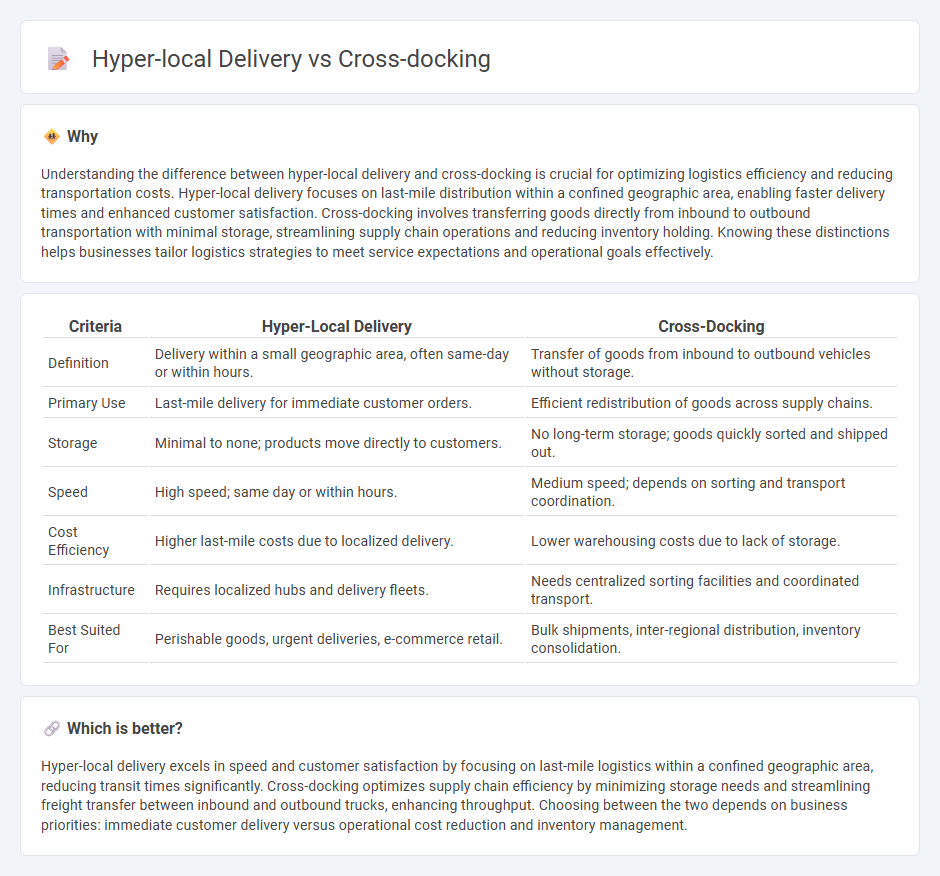
Hyper-local delivery focuses on transporting goods within a very limited geographic area, often ensuring same-day or even hour-level delivery times, ideal for urban settings and immediate customer needs. Cross-docking, in contrast, streamlines the supply chain by transferring products directly from inbound to outbound transportation with minimal storage, enhancing efficiency for larger-scale distribution networks. Discover how these logistics strategies can optimize your delivery operations and customer satisfaction.
Why it is important
Understanding the difference between hyper-local delivery and cross-docking is crucial for optimizing logistics efficiency and reducing transportation costs. Hyper-local delivery focuses on last-mile distribution within a confined geographic area, enabling faster delivery times and enhanced customer satisfaction. Cross-docking involves transferring goods directly from inbound to outbound transportation with minimal storage, streamlining supply chain operations and reducing inventory holding. Knowing these distinctions helps businesses tailor logistics strategies to meet service expectations and operational goals effectively.
Comparison Table
| Criteria | Hyper-Local Delivery | Cross-Docking |
|---|---|---|
| Definition | Delivery within a small geographic area, often same-day or within hours. | Transfer of goods from inbound to outbound vehicles without storage. |
| Primary Use | Last-mile delivery for immediate customer orders. | Efficient redistribution of goods across supply chains. |
| Storage | Minimal to none; products move directly to customers. | No long-term storage; goods quickly sorted and shipped out. |
| Speed | High speed; same day or within hours. | Medium speed; depends on sorting and transport coordination. |
| Cost Efficiency | Higher last-mile costs due to localized delivery. | Lower warehousing costs due to lack of storage. |
| Infrastructure | Requires localized hubs and delivery fleets. | Needs centralized sorting facilities and coordinated transport. |
| Best Suited For | Perishable goods, urgent deliveries, e-commerce retail. | Bulk shipments, inter-regional distribution, inventory consolidation. |
Which is better?
Hyper-local delivery excels in speed and customer satisfaction by focusing on last-mile logistics within a confined geographic area, reducing transit times significantly. Cross-docking optimizes supply chain efficiency by minimizing storage needs and streamlining freight transfer between inbound and outbound trucks, enhancing throughput. Choosing between the two depends on business priorities: immediate customer delivery versus operational cost reduction and inventory management.
Connection
Hyper-local delivery relies on cross-docking to expedite the movement of goods by minimizing storage time and enabling faster last-mile distribution within localized areas. Cross-docking facilities sort and consolidate shipments efficiently, reducing handling costs and improving delivery speed for hyper-local fulfillment. This integration enhances supply chain responsiveness and supports real-time inventory management crucial for customer satisfaction.
Key Terms
Distribution Center
Cross-docking streamlines distribution center operations by minimizing inventory holding time, enabling goods to move directly from inbound to outbound transportation with minimal storage. Hyper-local delivery leverages distribution centers as strategic nodes to swiftly fulfill nearby customer orders, emphasizing rapid last-mile delivery through advanced routing and real-time inventory management. Discover how optimizing your distribution center can enhance efficiency in both cross-docking and hyper-local delivery models.
Last-Mile Delivery
Cross-docking minimizes storage time by quickly transferring goods from inbound to outbound transportation, streamlining inventory flow for efficient last-mile delivery. Hyper-local delivery targets customers within a small, predefined geographic area, ensuring rapid fulfillment and reduced delivery times through proximity. Explore the benefits and strategies of each approach to enhance your last-mile logistics.
Inventory Turnover
Cross-docking minimizes inventory holding by transferring goods directly from inbound to outbound transportation, significantly boosting inventory turnover rates. Hyper-local delivery emphasizes rapid, last-mile distribution within a localized area, often relying on regional inventory hubs to meet immediate demand, which can moderate turnover speed compared to cross-docking systems. Explore the nuances of cross-docking and hyper-local delivery strategies to optimize your inventory turnover effectively.
Source and External Links
Cross Docking: Definition, History, and Process - Cross-docking is a shipping method that transfers goods directly from inbound to outbound transportation modes with minimal storage, using methods like continuous cross-docking, consolidation, and deconsolidation to improve efficiency and reduce handling time.
What Is Cross-Docking? Definition, Types & Advantages - Cross-docking is a logistics technique that speeds delivery and cuts costs by unloading goods from inbound vehicles and immediately loading them onto outbound vehicles, minimizing warehouse storage and optimizing inventory control.
Understanding cross-docking: A comprehensive guide - Cross-docking involves transferring products with minimal storage time and includes types like pre-distribution, post-distribution, continuous, consolidation, and deconsolidation, with specialized forms serving retail, manufacturing, and e-commerce sectors.
 dowidth.com
dowidth.com